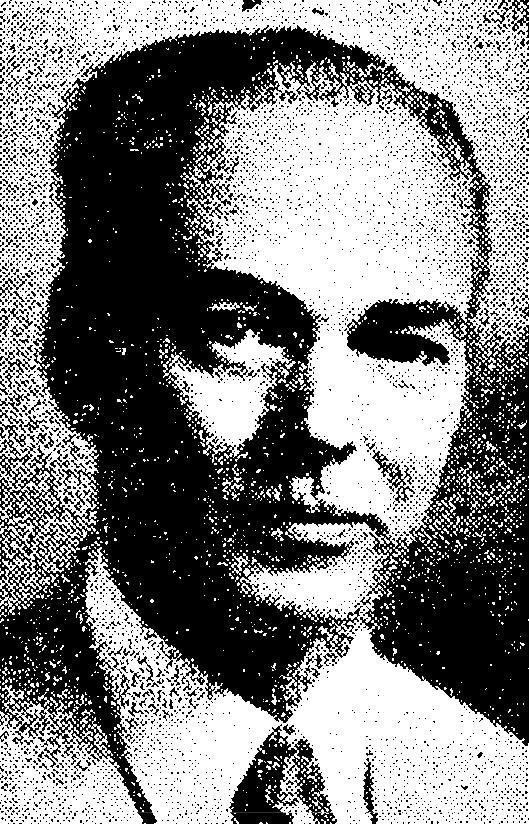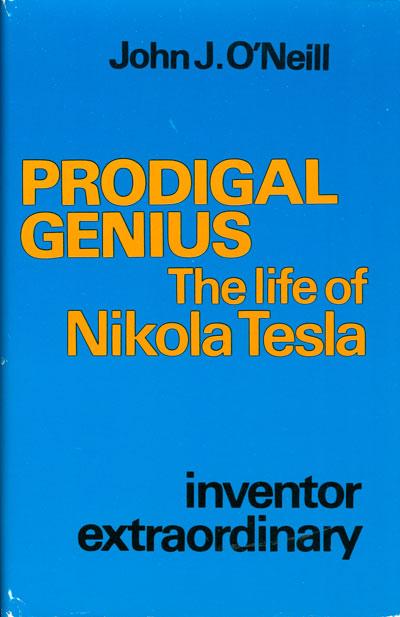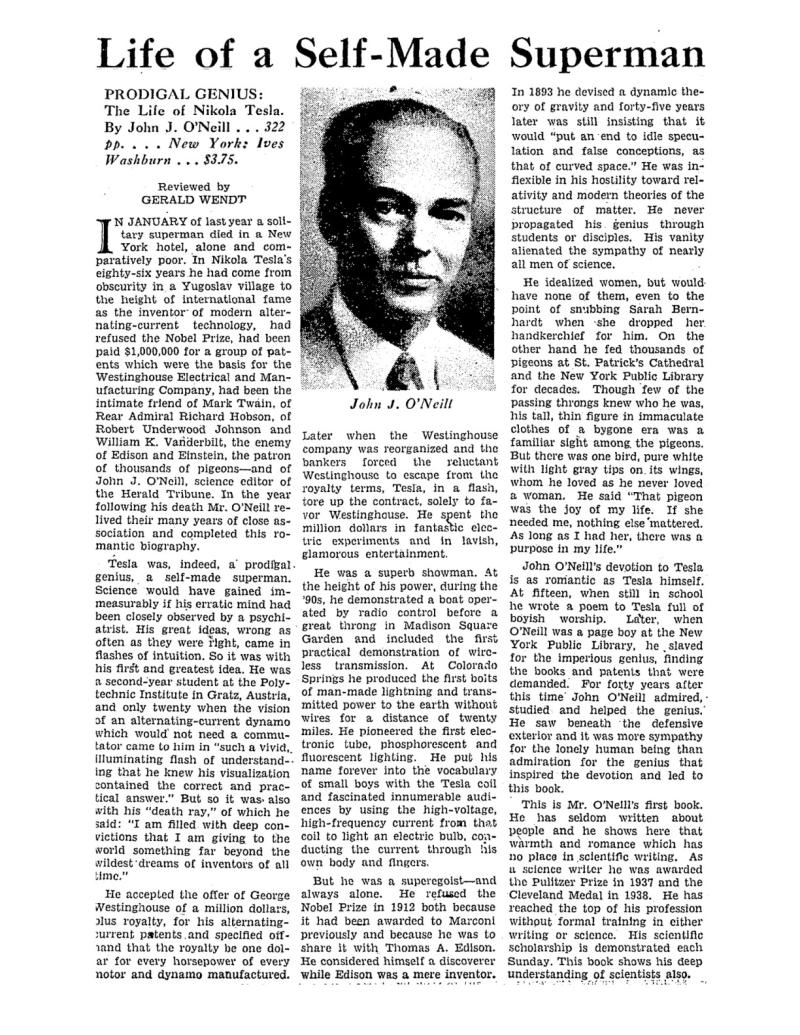
Nikola Tesla Articles
Life of a Self-Made Superman
In January of last year a solitary superman died in a New York hotel, alone and comparatively poor. In Nikola Tesla's eighty-six years he had come from obscurity in a Yugoslav village to the height of international fame as the inventor of modern alternating-current technology, had refused the Nobel Prize, had been paid $1,000,000 for a group of patents which were the basis for the Westinghouse Electrical and Manufacturing Company, had been the intimate friend of Mark Twain, of Rear Admiral Richard Hobson, of Robert Underwood Johnson and William K. Vanderbilt, the enemy of Edison and Einstein, the patron of thousands of pigeons-and of John J. O'Neill, science editor of the Herald Tribune. In the year following his death Mr. O'Neill relived their many years of close association and completed this romantic biography.
Tesla was, indeed, a prodigal. genius, a self-made superman. Science would have gained immeasurably if his erratic mind had been closely observed by a psychiatrist. His great ideas, wrong as often as they were right, came in flashes of intuition. So it was with his first and greatest idea. He was a second-year student at the Polytechnic Institute in Gratz, Austria, and only twenty when the vision of an alternating-current dynamo which would not need a commutator came to him in "such a vivid, illuminating flash of understand-. ing that he knew his visualization contained the correct and practical answer." But so it was also with his "death ray," of which he said: "I am filled with deep convictions that I am giving to the world something far beyond the wildest dreams of inventors of all time."
He accepted the offer of George Westinghouse of a million dollars, plus royalty, for his alternating-current patents and specified off and that the royalty be one dollar for every horsepower of every motor and dynamo manufactured.
Later when the Westinghouse company was reorganized and the bankers forced the reluctant Westinghouse to escape from the ash, royalty terms, Tesla, in a tore up the contract, solely to favor Westinghouse. He spent the million dollars in fantastic electric experiments and in lavish, glamorous entertainment.
He was a superb showman. At the height of his power, during the '90s, he demonstrated a boat operated by radio control before a great throng in Madison Square Garden and included the first practical demonstration of wireless transmission. At Colorado Springs he produced the first boits of man-made lightning and transmitted power to the earth without wires for a distance of twenty miles. He pioneered the first electronic tube, phosphorescent and fluorescent lighting. He put his name forever into the vocabulary of small boys with the Tesla coil and fascinated innumerable audiences by using the high-voltage, high-frequency current from that coil to light an electric bulb, conducting the current through his own body and fingers.
But he was a superegoist - and always alone. He refused the Nobel Prize in 1912 both because it had been awarded to Marconi previously and because he was to share it with Thomas A. Edison. He considered himself a discoverer while Edison was a mere inventor.
In 1893 he devised a dynamic theory of gravity and forty-five years later was still insisting that it would "put an end to idle speculation and false conceptions, as that of curved space." He was inflexible in his hostility toward relativity and modern theories of the structure of matter. He never propagated his genius through students or disciples. His vanity alienated the sympathy of nearly all men of science.
He idealized women, but would have none of them, even to the point of snubbing Sarah Bernhardt when she dropped her. handkerchief for him. On the other hand he fed thousands of pigeons at St. Patrick's Cathedral and the New York Public Library for decades. Though few of the passing throngs knew who he was, his tall, thin figure in immaculate clothes of a bygone era was a familiar sight among the pigeons. But there was one bird, pure white with light gray tips on, its wings, whom he loved as he never loved a woman. He said "That pigeon was the joy of my life. If she needed me, nothing else 'mattered. As long as I had her, there was a purpose in my life."
John O'Neill's devotion to Tesla is as romantic as Tesla himself. At fifteen, when still in school he wrote a poem to Tesla full of boyish worship. Later, when O'Neill was a page boy at the New York Public Library, he slaved for the imperious genius, finding the books and patents that were demanded. For forty years after this time John O'Neill admired, studied and helped the genius. He saw beneath the defensive exterior and it was more sympathy for the lonely human being than admiration for the genius that inspired the devotion and led to this book.
This is Mr. O'Neill's first book. He has seldom written about people and he shows here that warmth and romance which has no place in scientific writing. As at science writer he was awarded the Pulitzer Prize in 1937 and the Cleveland Medal in 1938. He has reached the top of his profession without formal training in either writing or science. His scientific scholarship is demonstrated each Sunday. This book shows his deep understanding of scientists also.



